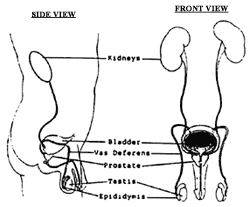
www.flinturology.com
Urology Services, Inc.
G-1121 West Hill Rd.
Flint, Michigan 48507
Tel: 810.232.8888
Fax: 810.232.9190
Email: jbauer@flinturology.com
[map]
 |
John J. Bauer, M.D.
www.flinturology.com Urology Services, Inc.
|
Prostate Cancer
John J. Bauer, MD, Urologist
Prostate cancer is the most common type of cancer in adult men. The prostate is a gland, which is part of the reproductive system. It makes a portion of the semen, which is the fluid that comes out at the time of ejaculation. The prostate wraps around the urethra, which is the urinary channel that drains urine from the bladder to the outside through the penis. The prostate begins to enlarge in a benign or non-cancerous fashion in almost all men beginning at the age of 40. As it does, it can compress the urethra and cause a change in the pattern of urination. While normal growth of the prostate affects most men, approximately 1 out of 11 men will develop cancer of the prostate. Every man should have an annual exam for prostate cancer with a combination of digital rectal exam and a PSA blood test. A digital rectal exam is carried out when a physician inserts a gloved finger into the rectal area to feel the surface of the prostate to determine if there are any areas of nodule formation or irregularity. The PSA level is checked by a blood test. PSA stands for prostate specific antigen, which is a protein made only in the prostate and not anywhere else in the body. If the PSA is elevated it may be a sign of prostate cancer. Other conditions can cause elevation of the PSA such as the normal enlargement of the prostate or inflammation of the prostate. If there is an abnormality on either digital rectal exam or PSA, a prostate ultrasound with biopsy can determine if prostate cancer is present. When prostate cancer is identified by biopsy, staging studies are carried out next to determine the extent of the prostate cancer. Prostate cancer can spread to the lymph nodes, the bones and the lungs. These areas are checked with a CT scan of the pelvis, a bone scan and a chest X-Ray. If there are abnormal areas on the bone scan, followup X-Rays and evaluation may be needed.

The extent of the cancer is referred to as the stage of disease. Stage A or T1 refers to disease which is identified incidentally at the time of surgery to remove a benign prostate. It also refers to cancers detected based on an elevated PSA without an abnormality on rectal exam. Stage B or T2 refers to cancer that can be felt on the digital rectal examination. Both Stage A and B (Tl and T2) are referred to as organ confined prostate cancer. Stage C or T3-4 disease includes those cancers that have spread outside the confines of the prostate. This determination is often made at the time of the rectal exam or the ultrasound examination. Stage D refers to those tumors, which have spread outside the prostate to the lymph nodes, bones or other sites.
Treatment of prostate cancer depends on the stage of disease and the age and overall health of the patient. Treatment options available for organ confined prostate cancer (Stage A and B. T1 and T2) include observation alone, radiation therapy and radical prostatectomy. In some places in this country, cryosurgery is also used to treat organ confined prostate cancer. Although publicized heavily, this technique is still in the investigational stages. It is currently not the standard of care and it is recommended that it only be carried out as part of an investigational protocol under the auspices of a university setting.
The rationale for observation alone as a treatment choice is the recognition that some men may die of other illnesses before they die of their prostate cancer. One of the difficulties encountered in treating prostate cancer is trying to predict its biologic potential. In the older man with other health troubles, and a type of cancer that does not appear particularly aggressive, it may be appropriate to choose observation. In the younger man, this is not the favorable choice since it can be anticipated that the cancer will spread outside the prostate in 60 to 70 % of men within 10 years after diagnosis. For those men in whom the cancer spreads outside the prostate, they may subsequently die secondary to complications from the prostate cancer.
Radiation therapy involves the application of x-ray treatment to the prostate in an effort to eradicate the cancerous cells or at least arrest their growth. Radiation can be delivered in two different forms: external beam radiotherapy or brachytherapy, (the insertion of radioactive seeds into the prostate). External radiation is typically given over a course of 30 to 40 treatments. It is usually given 5 days a week for a 6 to 8 week treatment total. Complications of radiation can include damage to the urinary bladder or the rectum. This can result in urinary frequency and urgency. It can also cause diarrhea and rectal pain. Incontinence, which is the loss of urinary control, develops in less than 1% of men. Impotence, the inability to get an erection, may develop on a delayed basis in up to 1/3 of patients. Radiation therapy has very effective treatment results at 5 and 10 years. The results are not as favorable at the 15 year mark. Radiation is a good choice for men in their 70's without other significant health troubles. It may at times be appropriate for men in their 60's who have other health troubles or who have a type of cancer with low biologic potential. If cancer remains in the prostate after radiation, a later attempt to remove the prostate through surgery is not a favorable option.
Brachytherapy is the term used to describe the insertion of radioactive seeds into the prostate. The rationale for inserting seeds directly into the prostate is that it allows a higher dose of radiation to be delivered to the prostate with less of an affect on adjacent organs. When this technique was first developed years ago, the main problem encountered was achieving an even distribution of the seeds. With the development of transrectal ultrasound, it became possible to distribute the seeds in an even fashion. More recently, techniques using CT guidance to place the seeds have been developed which appear to provide even more precise placement of the seeds. Long-term studies regarding treatment outcome are not yet available. However, preliminary information indicates that brachytherapy is at least as effective as external radiation therapy and may be as effective as radical prostatectomy. Seed placement is now done on an outpatient basis under epidural anesthesia. Impotence may develop but incontinence rarely develops in patients treated with seeds. Please see the comments of Dr. Patrick Walsh, a leading advocate of surgical extirpation of localized prostate cancer regarding the recent claims of those performing brachytherapy. There are definitely differing opinions regarding the effectiveness of this therapy. The patient must chose the therapy that best fits his goals and lifestyle choices.
Radical prostatectomy refers to the surgical removal of the prostate. Surgery is carried out through an incision that runs from the belly button to the pubic bone. At surgery, the first step is the removal of the lymph nodes to determine if there are microscopic areas of cancer spread. After lymph node removal, the prostate and the attached seminal vesicles, which are accessory glands of the prostate, are removed. The bladder is then rejoined to the urethra. Surgery typically involves a 5 to 6 day hospital stay. A catheter, which is a tube to drain urine out of the bladder, is in place for 3 weeks. Potential complications related to the surgery itself include bleeding and infection. There are also the general risks of an operation, such as a blood clot in the legs, heart irregularity, pneumonia and so forth. Long-term potential problems include incontinence and impotence. Impotence develops in at least half of the patients even with application of the "nerve sparing" techniques. Surgery is the treatment of choice for men in their 50's and early 60's. It is also a good choice for men in their late 60's and very early 70's who do not have other health problems and whose life expectancy is at least 10 years. Surgery has the advantage over radiation of having better long-term outcomes in terms of survival and disease-free survival at the 10 and 15-year mark. On some occasions, men who are treated with radical prostatectomy can require additional therapy once they recover from surgery. If there are microscopic areas of lymph node involvement, hormonal therapy may be required (see below).
If there is evidence of extension of the cancer up to the margins of the surgical resection, radiation may be added as follow-up treatment. For men with Stage C (T3-4) disease, treatment options include observation, radiation and hormonal therapy. Radiation therapy may provide control of local symptoms that would otherwise develop due to the size of the cancer as it encroaches on the urethra and bladder. Radical prostatectomy is typically not recommended for Stage C disease except in the very young man.
For those with Stage D disease, the primary treatment is hormonal therapy. Prostate cancer depends on testosterone, the male hormone, to grow and flourish. There are different ways to remove testosterone. These all fall under the collective term "hormonal therapy." One of the simplest ways to remove testosterone is with orchiectomy.
Orchiectomy refers to the surgical removal of the testicles, the site where testosterone is produced. Another popular alternative is the administration of an injection every three months, which keeps the testicles from making testosterone. This type of medicine, known as a GNRH analog, is available as either Lupron or Zoladex. The advantage of this form of therapy is that it avoids the need for surgery. The relative disadvantage is the increased cost compared to orchiectomy..
Often times, in combination with either orchiectomy or a GNRH analog, an anti-androgen is used as well. Currently, the anti-androgen used is Flutamide (Eulexin), which is taken as one to two tablets 3 times a day. This interferes with the small amount of testosterone made by the adrenal gland. Side effects of hormonal therapy include impotence in all men and hot flashes in some men. There are now many other options for anti-androgens such as Casodex (Biclutamide) and Nilandron (nilutamide), both of which are taken less frequently and have lower gastrointestinal side effects
The topic of prostate cancer can be very confusing for patients. Invariably, each patient knows other men who are being treated for prostate cancer. It is difficult to understand why one treatment is used in one man and a different treatment is used in another. Again, much of the treatment choice depends on the patient's age and overall health. In general, men do well with prostate cancer, provided it is diagnosed early and treated appropriately.